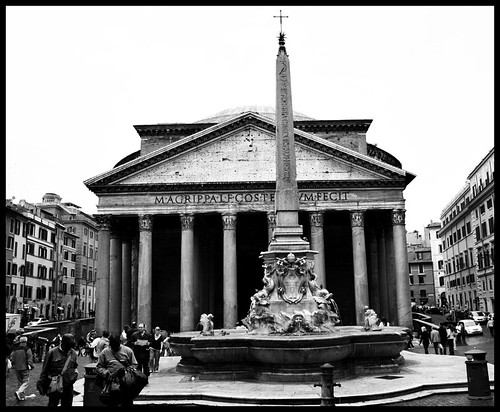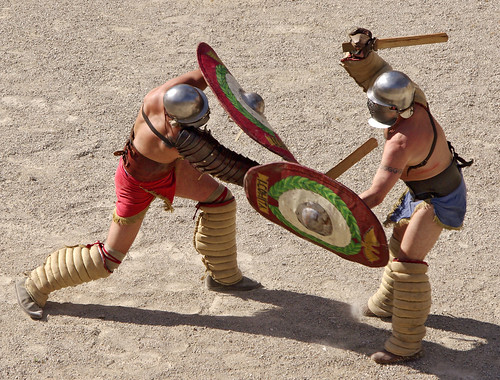By the time of the emperors, the Romans had created the world’s first global empire stretching from Morocco in the west to Iraq in the east, and from Scotland in the north to Egypt in the south. Around this empire flowed a treasure trove of goods from far flung lands: slaves, spices, precious stones, and coloured marble, as well as an exotic array of foods and wine. From this bounty, the Romans created a culture of pleasure and a passion for sensations that stimulated all the human senses: vision, hearing, smell, touch and so on. A global world of pleasure had arrived.
1: Binge Drinking
It was under the emperor Tiberius that the Romans developed a taste for drinking on an empty stomach. Wine was available in quantity as well as quality, the former was cheap and mass produced – sometimes needing to be sweetened with lead acetate or more expensively with honey. At the Saturnalia (December Festival), drinking was the done thing with both the Romans and their slaves drinking large quantities of wine. Bars can be found throughout Pompeii, some opposite the famous brothel (sex with a prostitute cost the equivalent of 2 glasses of wine). Scenes of dinner parties in frescoes from Pompeii, often include semi-naked males and dressed females – one of whom is usually vomiting. The conclusion of the bibulous scene leads to nudity and sex in the mind of the viewer.
2: Getting Naked

The Romans liked to get clean in company, and that company was undressed.
The development of window glass in the first century AD transformed the bathing experience from a dark dingy steamy event into a new experience. The baths were now well-lit and beautiful structures with mosaics, clear water, and populated by naked bodies – some included mixed bathing, others single sex.
The passage through the unheated room (frigidarium) into warmer heat (tepidarium) and on into the hottest rooms (caldarium) were associated with the skin feeling the changes in temperature – rounded off perhaps with a cold plunge. The tactile feeling of hot and cold was further accentuated by oiling of the body, massage and the scraping of the oil off. Nude sun-bathing was also a possibility at the baths. Public nudity was contained in one location – the baths.
3: Grand Designs
Romans had a passion for building. All the more famous characters from Roman history have at least one iconic building: Pompey’s Theatre, Augustus’ Forum, Nero’s Golden House, Vespasian’s Colosseum, Trajan’s Forum, the Pantheon of Hadrian and so on.
The sophistication of architecture did not just reside at the emperor’s pleasure. Villas in the first century AD developed ever greater sophistication of design to incorporate dining rooms in caves, for example at Sperlonga, or views across the Bay of Naples found in the Villa of San Marco at Stabiae. Whilst in the public domain, we find theatres and amphitheatres being built in most of the towns of Italy during the first century AD.
4: The Older Woman
Roman history is full of sex. There is Augustus’ daughter Julia, who had sex in the forum and was exiled. There is Claudius’ wife Messalina having sex in a brothel, and there is Clodia, the seductress of young men. All these women were mothers in their late 20s or 30s, rather than the young idealised virgin wives who were married off in their teens.
Cleopatra was not young when she seduced Antony, but for the Romans she was far sexier because she was older.These were also powerful women and perhaps this is how the Romans conceptualised their appeal as powerful and thus also sexy. This leads us, when reading Roman history, to locate an eroticisation of the mothers of others. There is always, of course, Nero, who broke all the rules and made love to his own mother – Agrippina.
5: The Younger Man
Roman men are difficult to classify via the terms homo-, bi-, and hetero-sexual. Looking at wall-paintings, graffiti, silver cups, pottery vessels and so on, we can find images of men having sex with both women and men. The Suburban Baths in Pompeii contains unique images of group sex with most permutations covered. However, when we turn to literature,
we find the expression of desire for younger males and the stories associated with young men that suggest that Male adults did have sex with young Roman men. The adoption of Octavian (the future emperor Augustus) by Julius Caesar was explained in sexual terms – Julius Caesar fell for the young man.
Disturbingly, the age range of desire was not confined to young adults but also included children for some. Perhaps given our own society’s experience, we might find this phenomenon unacceptable but not surprising. A sexual desire for young men was seen as normative; whereas sexual desire for men who were of their own age was deviant, and caused men to be seen as soft or as 'cinaedi' (feminine men), as opposed to real men or masculine men.
6: Song and Dance
Only very recently has it become realised quite how much the Romans loved music. Most know of Nero’s attempts at singing and lyre playing, but there are other examples of senators playing instruments and even at dawn blowing a trumpet to celebrate the beginning of their consulship. Alongside music went dance and the ability to perform. In AD 59, an 80-year-old lady danced in a pantomime – dancing lasted a lifetime and it was something that needed to be learnt.
Dance schools and music lessons were part of a Roman upbringing as much as they might be today in North London. Of course, dancing was not seen as ideal for the robust young citizen of Rome – we are told of a grandmother who had a passion for holding cabaret in her villa, but she consistently shielded her grandson from the performers living at her house.
7: Violence
We have trouble as human beings today admitting that men certainly (and perhaps women, too) tend to enjoy violence. Whether this is dishing out punishments to prisoners in Iraq, watching the boxing on TV or witnessing the fantasy of a film that seeks to include not just fight scenes but also torture.
The Romans were clear on this: even the reluctant viewer of the gladiators in the amphitheatre would become impassioned by the experience and cry out or scream for the demise of the unfavoured player in the game of death before him.
Violence at the games was staged – mythological enactments of the flight of Icarus involved the criminal being dressed with wings to fly across the amphitheatre with the twist that his wings fell off and he crashed to the arena floor. The victims of the Roman state needed to suffer and to be seen to suffer.
8: Collecting
The Roman Empire was founded on military expansion that involved the looting of booty from the enemy for the soldiers and for the Roman state. The conquest of Macedonia resulted in so much loot coming in that taxation was abolished in Italy in 167 BC. Much of the booty was melted down, but statues in bronze were prized items and came to litter the villas of the wealthy. Particularly prized were items that had been owned by the great men of a former age – Alexander the Great or Hannibal. Like modern collectors, the Romans also had a desire to show off their collection to the public. Tiberius built the Temple of Concordia in a quite novel form – it had wings for the display of Greek sculpture that was up to 400 years old.
9: Food
The Romans had a palate accustomed to the full range of tastes: sweet, sour, bitter, salty and the fifth taste umani that we associate with what could be described as a meaty flavour with cheesy bits. This was derived in part from garum or fish sauce, similar to that found in Thai food today.
What the Romans did with these tastes was to combine them to make ever new sensations that can be found in Apicius’ famous cook book of 450 recipes. The key to food preparation was the use of numerous ingredients, including the spices imported from India or even beyond. Recipes could include the cooking of flamingos but might also include a barley soup.
The most famous meal from the Roman period is the fictional dinner of Trimalchio – a freed slave, who misunderstands conventions and whose guests were served up an elaborate meal but poor conversation.
Food was also fragrant, so that the guests would have their nostrils stimulated. Visually, the room and the food as presented was a spectacle: the waiters were beautiful and eroticised under the gaze of the diners. Dinner was quite literally a sensation.
10: The Danger of Pleasure
The Romans did not sit comfortably with their passions. There was a view that pleasure had made Roman citizens and the state soft. This was a vision of what could be described as collective moral decline that explained why the present of the vast Roman Empire in the first century AD was more dominant, but life was not better. Pleasure was imported into Britain after its conquest in AD 43 with the result the independent Britons were enslaved by warm baths and dinner parties, according to Tacitus. New pleasures – such as drinking at the baths – were condemned by older men. And perhaps this is the key to the Roman passion for new and more elaborate forms of pleasure – you needed someone to offend, to tell you that you had flouted convention, and so on. Later in life, a person might develop a stoicism to survive old age – the time of life at which many Romans turned to philosophy and condemnation the behaviours of those younger than themselves.
Source from : http://heritage-key.com
For more interesting topics related to archaeology, visit archaeology excavations.
Archaeology excavation is best known and most commonly used within the science of archaeology. In this sense it is the exposure, processing and recording of archaeological remains.
Tuesday, February 22, 2011
Top 10 Passions of Ancient Rome: Sex, Binge Drinking, and the Culture of Pleasure
Subscribe to:
Post Comments (Atom)
No comments:
Post a Comment